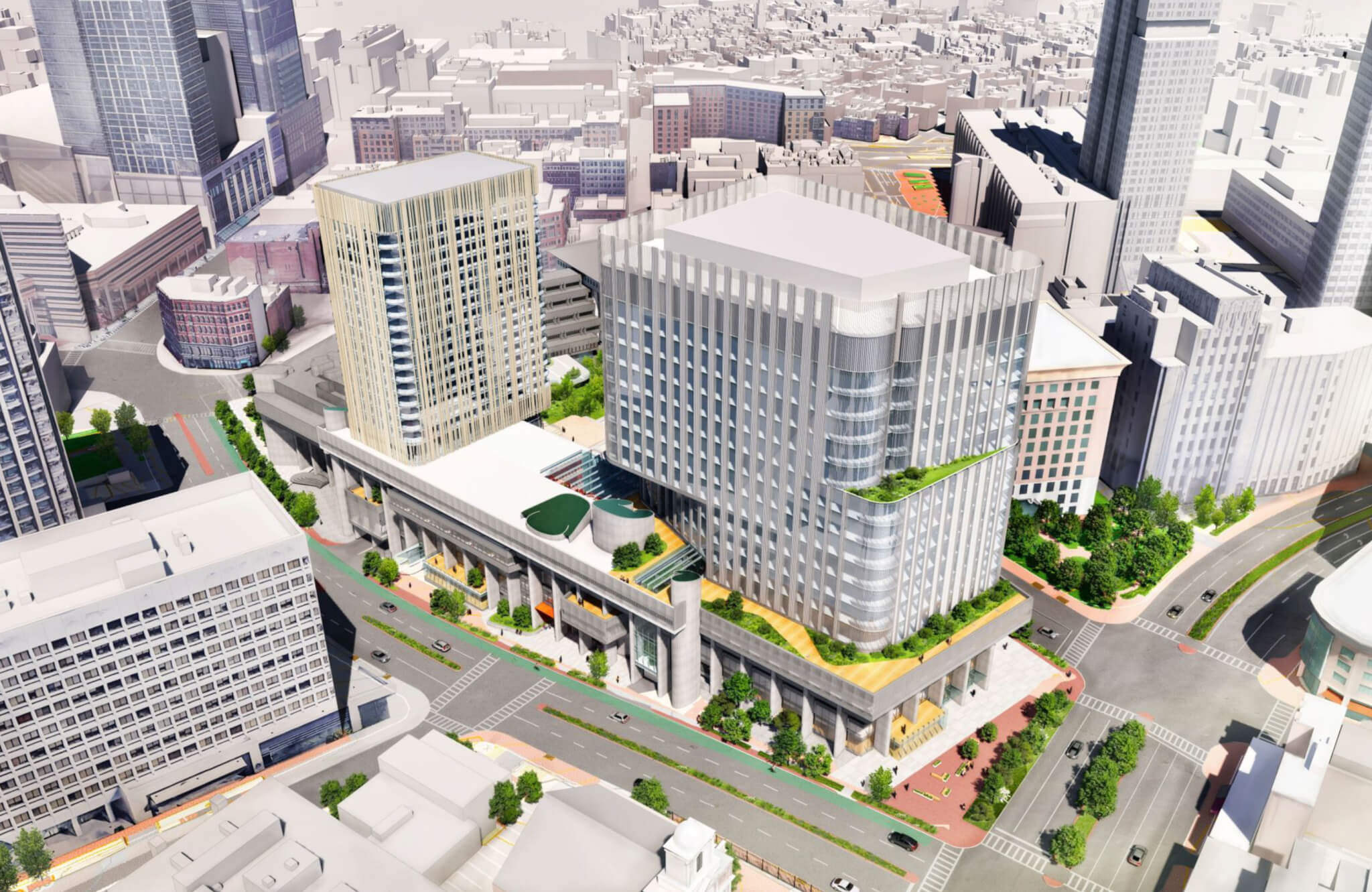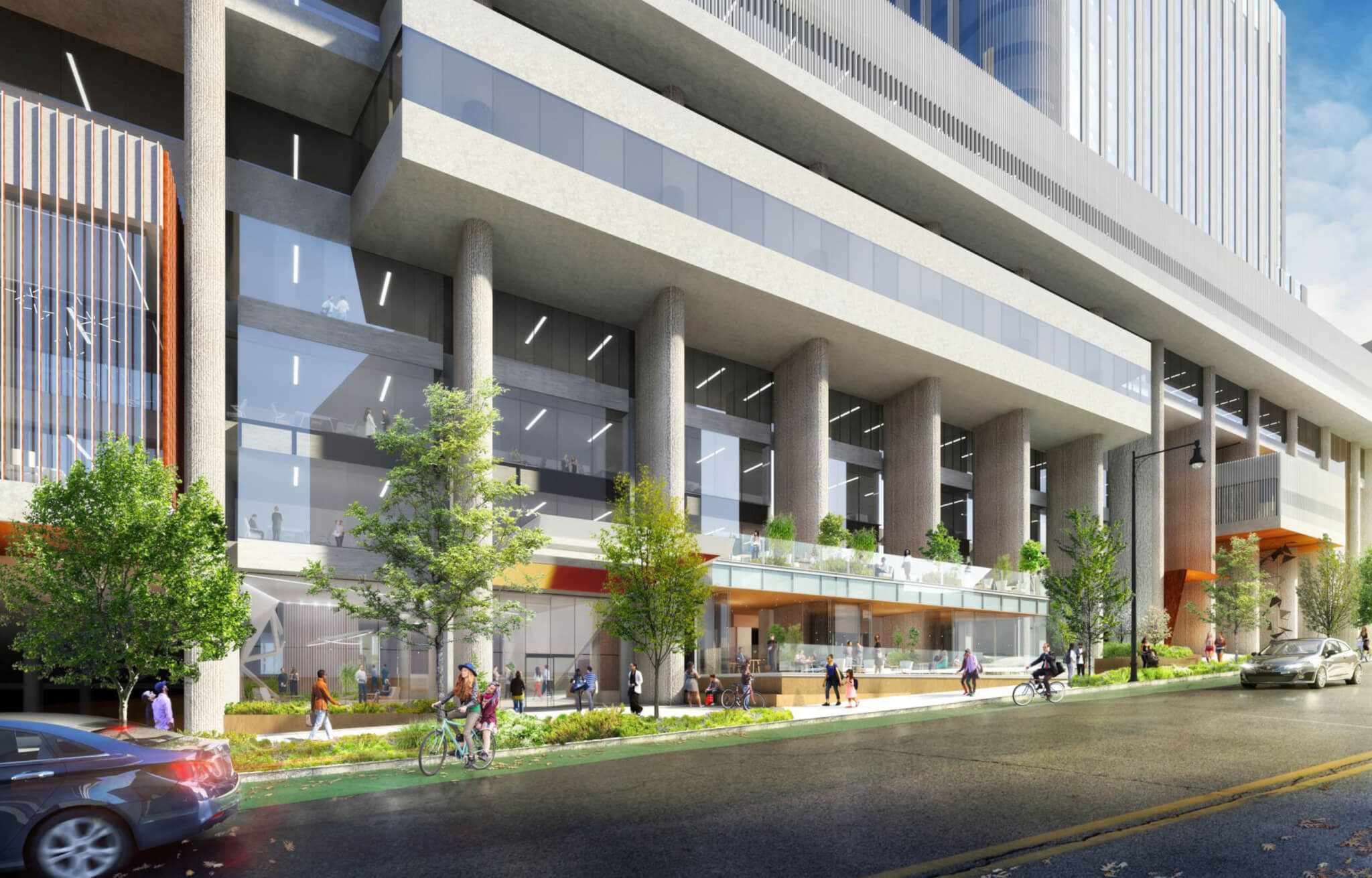Boston’s Brutalist Government Center—the Charles F. Hurley Building, or simply the Hurley Building—is making a comeback. The hulking Paul Rudolph–designed concrete structure was listed for sale in 2019, with Massachusetts Governor Charlie Baker calling for the building and surrounding 5-acre site to be redeveloped rather than reused. Well, Baker got his wish, a new development scheme announced by the Commonwealth of Massachusetts reenvisions the building and its surrounding landscape as a mixed-use development.
Renderings of the new project by global architecture firm NBBJ show the Hurley Building acting as a base for two new cylindrical towers, which will provide space for a new life sciences building, offices, retail, 200 housing units, and substantial park space.
The newly tapped developer of the site Leggat McCall Properties (LMP) will work alongside NBBJ and preservation architects Beyer Blinder Belle on a design that “honors” the building’s architectural significance while still providing much-needed upgrades.

“This transformative redevelopment partnership will not only revitalize the Hurley Building site, but will also improve the surrounding neighborhood, add much-needed housing, and boost the Commonwealth’s world-class life sciences sector,” said Baker in a press release. “We look forward to working with LMP and local partners on this project which will add open public space and improve the pedestrian experience throughout the neighborhood.”
Rudolph’s design, completed in 1971, is part of a multiblock scheme comprising the Hurley building, the adjacent Lindemann Building—the Hurley building’s doppelgänger, not part of the latest redevelopment—and a connecting courtyard. The Hurley Building was abandoned by its predecessor tenant for its lack of windows and outdated urban landscape. It has since been subject to a number of plans, including one which called for a partial to full removal of the concrete structure and another in which the building was completely torn down.
This Hurley Building is not the first of Rudolph’s designs to be at risk of demolition or criticized for its appearance. Other designs by the late architect, including his Shoreline Apartment in Buffalo have faced similar fates. A public aversion to Brutalism that stems from relating the architectural style with failed urban renewal projects and government overreach and a lack of funding for upkeep are among the reasons as to why the structures are demolished. When notice of the redevelopment first circulated it spurred debate among pro-Brutalists who demanded its preservation, and alternatively, locals who praised the change for what they considered to be nothing more than an eyesore.

While the extent, and cost—with maintenance alone totaling $225 million—of the project is quite drastic, a portion of the existing building will be retained. The interiors will be overhauled to incorporate new office space for government use while retail spaces will be added to the ground floor.
A center point of the redevelopment will be a life sciences building outfitted with substantial lab space. The building’s advantageous location near Cambridge’s Kendall Square, a neighborhood bursting with biotech and science-focused businesses, and the Mass General Hospital campus places it within an area that has seen significant economic growth from the biotech and life sciences industries.
The redesign of the building and surrounding site is the result of a comprehensive community outreach and Request for Proposals process that engaged local advisory groups, preservation advocates, and state and local officials to weigh in on what they envisioned for the redevelopment. The proposal is still merely a proposal, and very much still in a preliminary stage and may morph as it passes through a regulatory review and permitting process.
Docomomo US and the Paul Rudolph Institute released a joint statement in response to the plan:
Speaking on behalf of Docomomo US, Liz Waytkus stated that, “The interventions at the Government Center need to harmonize with the historic site. The announcement yesterday lacked a lot of information as to how that is going to happen. Docomomo US will continue to follow along and engage in this process.”
“Rudolph’s building is a monument to the government’s service to its people and their confidence in the future of Boston,” said Kelvin Dickinson, President of The Paul Rudolph Institute for Modern Architecture. “Using spatial motifs that reference Boston’s historic connection to the sea, the Government Center is a unique symbol of its time and place. The revisions proposed in yesterday’s announcement need to better show how they are consistent with the design guidelines Rudolph established for the site. The Paul Rudolph Institute will follow and encourage this throughout the design process.”
If all goes according to plan, the project is slated to break ground in 2025.











